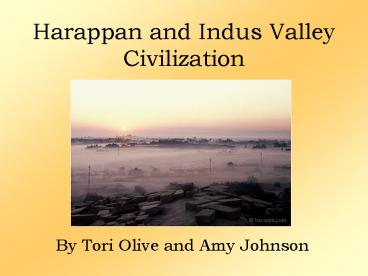Harappan and Indus Valley Civilization - PowerPoint PPT Presentation
1 / 14
Title:
Harappan and Indus Valley Civilization
Description:
Nomads settled in region west of the Indus River on the Pakistan/Iran border ... For transporting materials they used pack animals, river boats, and bullock carts ... – PowerPoint PPT presentation
Number of Views:851
Avg rating:3.0/5.0
Title: Harappan and Indus Valley Civilization
1
Harappan and Indus Valley Civilization
- By Tori Olive and Amy Johnson
2
Geography
- Located in present-day Pakistan along the Indus
River - Mountainous regions west of the river
- Abundant precipitation and humidity
3
Migration
- Nomads settled in region west of the Indus River
on the Pakistan/Iran border - They moved eastward to the Indus River at Karachi
- Indo-Aryans migrated to Harappa during 2000 BCE
- They shifted from North Western South Asia to the
Ganges River and South Asia
4
Population
- The projected population for the entire region is
between one and five million (6 people per square
kilometer) - Mohenjo-Daro and Harappa combined had a
population of 150,000 - The total urban population was 250,000
- Its hypothesized that a population increase in
3000 BCE is what lead the settlements on the
Pakistan/Iran border to migrate towards the Indus
River - Its also hypothesized that the general
population of the civilization decreased when the
Aryans invaded
5
Trade
- The Harappan civilization had active trading with
Sumer, Mesopotamia, Afghanistan, Persia, Africa,
Central Asia, and throughout the Arabian Gulf
- Traded lumber, copper, gold, ivory, beads,
shells, pottery, turquoise, cotton, grain, and
livestock - For transporting materials they used pack
animals, river boats, and bullock carts
6
Agriculture
- Driven by horticultural endeavors
- Massive granaries stored cereal crops and rice
- Grew mustard, sesame seeds, and dates
- Several species of animals were domesticated,
such as camels, cats, dogs, goats, sheep, and
buffalo
7
Social, Gender, and Family Structure
- Most of the civilization was urban and mercantile
- Simplistic lifestyle, few material goods
- No distinct social classes
- The powerful had many resources
- Like most early civilizations, the Indus River
Valley was dominantly patriarchal - Men were the head of the household
- Women and children did nothing unless their
husband or father gave them explicit permission
8
Disease
- Bone samples show few signs of disease or
malnourishment - Its predicted that there were minimal
gastrointestinal and similar infections due to
high standards of hygiene
- The occasional skull showing cranial lesions hint
that people may have had iron deficiencies and
subsequently got chronic anemia
9
Military
- There is no hard evidence of military activity,
although the cities did have fortifications
- A theory about the disappearance of the Indus
River civilization is that war-like Aryans and
Indo-Europeans invaded in 1700-1500 BCE
10
Weaponry
- Knives, spears, and arrowheads were used,
although this society was peaceful - Weapons were crafted from copper and bronze, but
never iron
11
Government
- Harappa was the capital of its province
- Individuals with important resources had most
power (merchants, ritual specialists, etc.) - Unified with extreme organization
- High regulation streets were crafted from a
rectangular grid pattern - Political structure was weakened by unknown
forces and then killed by invasion from Eurasia - Governed through control of trade and religion
- Rulers showed status through seals and fine
jewelry
12
Art and Technology
- 1st standardized system of weights and measure
- Dancing, painting, pottery, modeling, weaving,
and metalworking - Carved copper seals
- Advanced architecture
- Very small, intricate sculptures
- Beautiful crafts made of bronze, gold, silver,
ivory, terracotta, and glazed ceramics
13
Religion
- Bath remains in Mohenjo-Daro suggest that
cleansing rituals might have been practiced - Archeological expeditions have uncovered
figurines of holy animals (bulls) and women - Special emphasis placed on fertility and earth as
the giver of life - People believed in an after-life dead were
buried with amulets and pottery
14
Writing/Literature
- Pictographic script still not deciphered
- No relationship to any other writing system
- Writing vanished after the decline of the
civilization
- Literature from the Harappan civilization has not
been found - They used a Dravidian language, which hasnt been
translated

